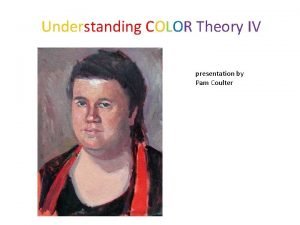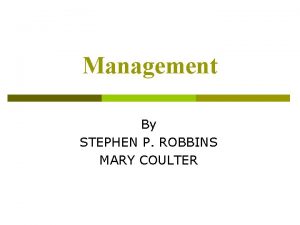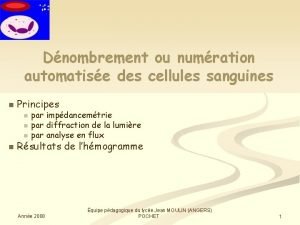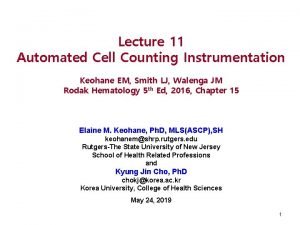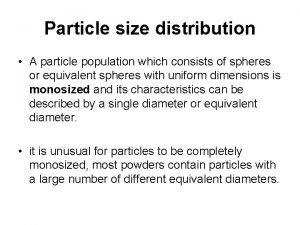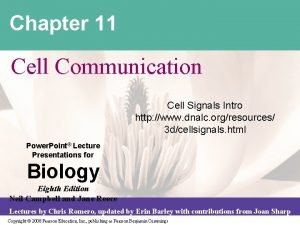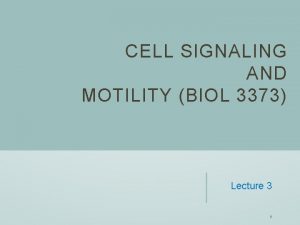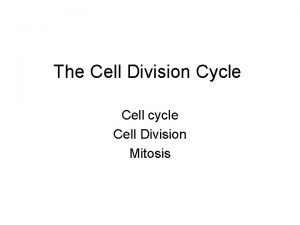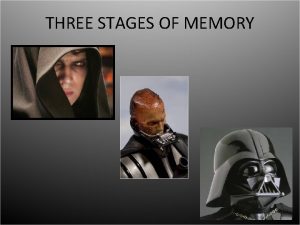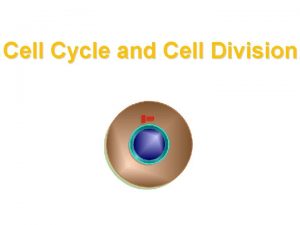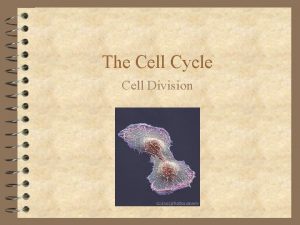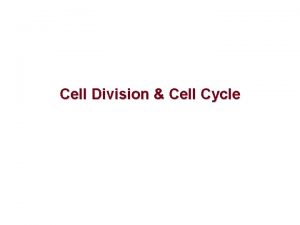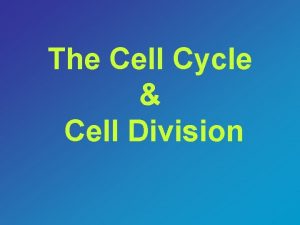Cell division Coulter Cell cycle Three stages Cell












- Slides: 12

Cell division Coulter

Cell cycle: Three stages • Cell cycle- regular sequence of growth and division that cells undergo. • Interphase • Mitosis • Cytokinesis

Interphase • • • Cell grows, makes a copy of DNA, and prepares to divide into two cells. Growth- cell grows to full size, makes copies of both mitochondria and chloroplasts. Copying DNA- cell makes an exact copy of DNA in its nucleus through a process called replication. Replication is very important, each daughter cell must have a complete set of DNA to survive. Preparing for division- cell produces structures that it will use to divide into two new cells.

Mitosis • One copy of the DNA is distributed into each of the two daughter cells. • Mitosis is divided into four parts: • • Prophase Metaphase Anaphase telophase

Prophase • Chromatin in the nucleus condense to form chromosomes. • The pairs of centrioles move to opposite sides of the nucleus. • Spindle fibers form a bridge between the ends of the cell. • The nuclear envelope breaks down. • Chromosomes have two rods because cell’s DNA is replicated. • • Each rod is called chromatid. Chromatid are held together by a structure called a centromere.

Metaphase • The chromosomes line up across the center of the cell. Each chromosome attaches to a spindle fiber at its centromere.

Anaphase • The centromeres split. The two chromatids separate. • One chromatid is drawn by its spindle fiber to one end of the cell. The other chromatid moves to the opposite end. • The cell stretches out as the opposite ends are pushed apart.

Telophase • The chromosomes begin to stretch out and lose their rodlike appearance. A new nuclear envelope forms around each region of chromosomes.

Cytokinesis • • • The cytoplasm divides. The organelles are distributed into each of the two new cells. Cytokinesis usually starts at the same time as telophase. At the end of cytokinesis each cell enters interphase, and the cycle begins again. In animals the cell membrane squeezes together around the middle and pinches into tow cells. In plants a cell plate is developed across the middle. The cell plate gradually develops into the cell membrane and a new cell wall then forms around.

Structure and replication of DNA • DNA replication ensures each daughter cell will have the genetic information it needs to carry out its activities. • 1952 Rosalind Franklin used an X-ray method to photograph DNA molecules. These photographs helped James Watson and Francis Crick figure out the structure of DNA in 1953

Structure of DNA • • • Two sides of the DNA ladder are made up of molecules of a sugar called deoxyribose, alternating with molecules known as phosphates. Each rung is made up of a pair of molecules called nitrogen bases (nitrogen containing) DNA has four kinds of nitrogen bases: • Adenine (A), thymine (T), guanine (G), cytosine (C) Adenine (A) only pairs with thymine (T) Guanine (G) only pairs with cytosine (C)

Replication process • DNA replication begins when the two sides of the DNA molecule unwind and separate. (like a zipper) • Because of the way in which the nitrogen bases pair with one another, the order of the bases in each new DNA molecule exactly matches the order in the original DNA molecule.
 Section 10-2 cell division
Section 10-2 cell division Cell cycle and cell division
Cell cycle and cell division Cell cycle phases
Cell cycle phases Management robbins coulter
Management robbins coulter The flow of communication
The flow of communication Pam coulter
Pam coulter Stephen p robbins
Stephen p robbins Idc hemogramme
Idc hemogramme Wdf cbc histogram
Wdf cbc histogram Coulter counter method
Coulter counter method Management by stephen p robbins 9th edition
Management by stephen p robbins 9th edition Chapter 11 cell communication
Chapter 11 cell communication Three stages of cell signaling
Three stages of cell signaling





